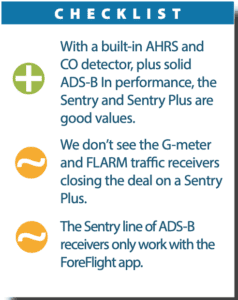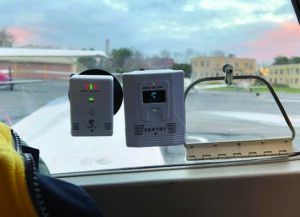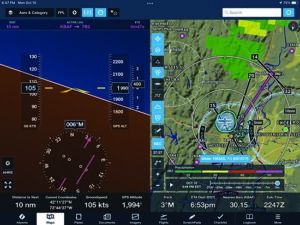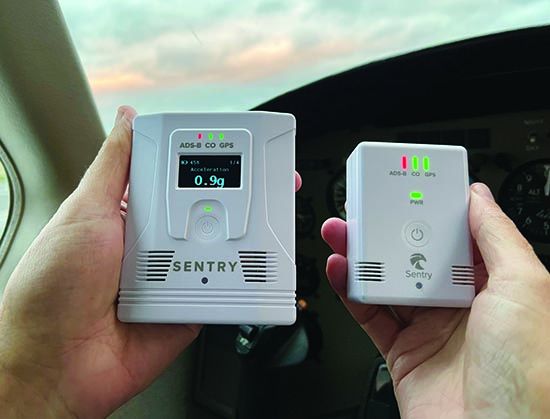Need an ADS-B receiver with that ForeFlight subscription? That’s just what ForeFlight has been offering, now adding a third portable ADS-B receiver to its Sentry line of traffic and weather receivers.
Made by uAvionix for ForeFlight and sold through Sporty’s, the Sentry line covers the top and bottom of the portable ADS-B receiver market. There’s the compact $349 Sentry Mini, the $599 Sentry and $799 Sentry Plus—the later muddying the buying decision. Let’s talk it through.
SIZE AND POWER
Since they are so close on features and design, we’ll concentrate on the Sentry and Sentry Plus. Compared, the entry-level Sentry Mini is built to save space and as such is stripped of an internal battery (it’s powered by external USB-C input), built-in AHRS, pressure altitude sensor and some other sensors/features that are standard in the higher-priced Sentry models.

The Sentry and Sentry Plus aren’t large portables, but the Plus is larger, as you can see in the lead image above. Part of that is to accommodate the built-in display and more sensors. There’s also more battery power. The Sentry was already good—with a 12-hour endurance—but the Sentry Plus is even better at 18 hours and the most of any portable ADS-B receiver on the current market. But the extra six hours of juice might not matter.
You decide if you’ll fly more than 12 hours at a clip without external power. Still, to maximize the battery life, the Sentry Plus was smartly tweaked to streamline and compress the communications between the ForeFlight iOS app and the device, which ForeFlight says makes Sentry’s processors run without gobbling large amounts of battery voltage. The other source of battery drain is the brightness of the Sentry Plus’s OLED screen. This one was designed to automatically lower the screen brightness to save power, but not to the point of sacrificing sunlight readability. It did we’ll in the cabins we tried it in. Sentry’s Wi-Fi power is also dynamically adjusted and does not require user control. As an observation from our use, battery life went from 45 percent to 30 percent in a 1.2-hour flight, but given the somewhat approximate nature of battery capacity measurements, we would not extrapolate that data point to an estimation of actual battery life.
Aside from smart power management, the Sentry’s battery can be charged while you use the device at the same time—something you can’t do with early-gen portables. It’s charged by connecting the supplied cable to any 5-volt USB-A port or power bank capable of delivering 2 amps of current. Worth mentioning is that fast-charging ports won’t work. A full charge of a completely empty battery takes between 10 and 12 hours. Remember to plug it in when you park the airplane on a trip. On the other hand, panel USB power ports are a common and convenient accessory. Consider having one installed during major avionics upgrades while the panel is open.
CO DETECTOR, G-METER
We like that both the Sentry and Sentry Plus are equipped with a built-in CO detector. ForeFlight says the expected life of the sensor is 10 years, which is typical. If you want to keep an eye on CO levels rather than relying on audible alarms, the Sentry Plus has a CO status feature that depicts carbon monoxide concentration. It’s pretty simple and elevated levels of CO are depicted as Caution or Danger. If either is displayed on the OLED screen, the concentration level (ppm) is also displayed in a ForeFlight Mobile app alert.
A feature that’s not included in the Sentry but standard on the Sentry Plus is the built-in real-time G-meter. In our estimation, the feature might be nearly useless for many (not all) users because of human factors. The Sentry Plus needs to be mounted in the cockpit to have a good antenna field of view for GPS satellites and also to stay out of the pilot’s field of view and flail zone in case of a crash. In a Piper Archer, we mounted it on the front left side pilot’s window. To observe the G-force display during a maneuver, we would have needed to turn the head about 90 degrees to the left and then refocused the eyes on the Sentry plus—which was about six inches from the head. In our view, that’s not what anyone would want to do be doing during a dynamic maneuver. If you fly serious aerobatics, you’ll likely have a panel-installed G-meter, so we just don’t see a lot of value in this Sentry Plus feature, although in our use it worked fine.

FLIGHT DATA RECORDING
The Sentry Plus is equipped with a built-in flight data recorder. The function automatically captures track, altitude, attitude, groundspeed and G-load data logged from Sentry Plus for every flight. The recorder automatically starts a track log each time the Sentry Plus is powered on, and it automatically records track logs continuously until powered off. When it has recorded 16 track logs, the oldest one is automatically overwritten with new track logs. Old track logs are overwritten even if they have not been imported. We found the track log files easy to download and manipulate and think they can be useful for training and flight planning.

FLARM TRAFFIC
While the Sentry Plus has an internal FLARM traffic receiver, we think ForeFlight/uAvionix missed a good opportunity to serve the United States soaring community, where air-to-air FLARM traffic receivers are common in modern gliders. Unfortunately, FLARM operates on different frequencies in different regions of the world, and the receiver in the Sentry Plus operates on the European FLARM SRD860 frequency band (868.2 MHz to 868.4 MHz). So for U.S. ops, the FLARM feature in the Sentry Plus is irrelevant.
WEIGHING OPTIONS
Our trials have easily proven that the Sentry and Sentry Plus are high-quality, reliable and well-engineered receivers that are we’ll supported by Sporty’s and ForeFlight. When placed properly in the cabin, the AHRS, GPS and ADS-B traffic and weather receivers work well, with a rich interface with the ForeFlight Mobile iOS app. But there’s a rub in there. These devices won’t work with any app other than ForeFlight. So if you’re a Garmin Pilot or other app user, you can’t use the Sentry receivers.
As we see it, existing Sentry users tempted to step up to the Sentry Plus simply need to decide if a G-meter, flight data recorder and longer battery life is worth the $799. For us it’s not. But if you fly gliders in Europe, we think it’s worth the utility to get FLARM capability. If we didn’t have any ADS-B receiver and were starting fresh, we’d probably pick the Sentry Plus over the Sentry for the $200 price delta for the CO level readout, flight recorder and better battery.
Visit www.foreflight.com and www.sportys.com.

See a video on the Sentry Plus at http://tinyurl.com/j95ht2a
Contributor Kenneth Katz is an aerospace engineer and an active instrument-rated pilot based in Connecticut.





